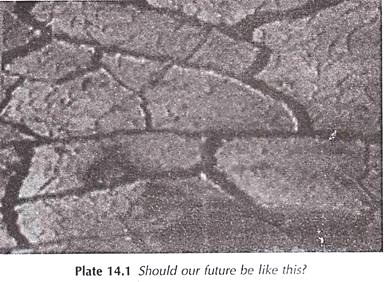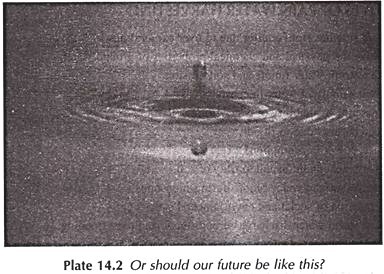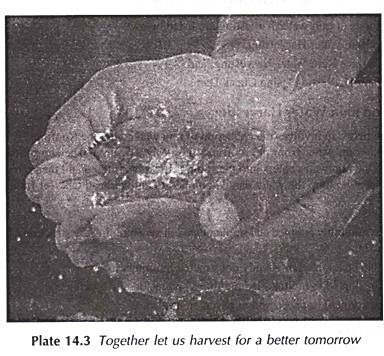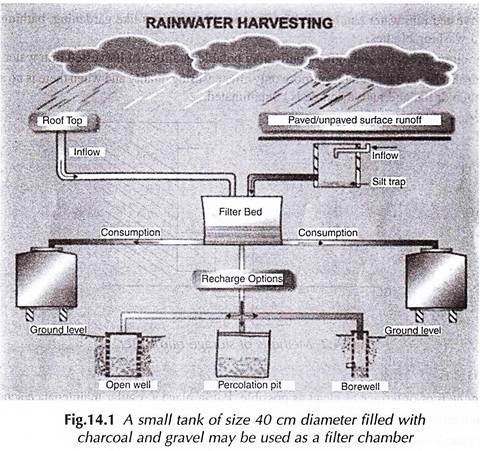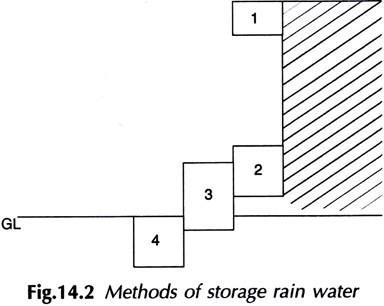Here is a compilation of essays on ‘Rainwater Harvesting’ for Class 7, 8, 9, 10, 11 and 12. Find paragraphs, long and short essays on ‘Rainwater Harvesting’ especially written for school and college students.
Essay on Rainwater Harvesting
Essay Contents:
- Essay on the Definition of Rainwater Harvesting
- Essay on the Importance of Rainwater Harvesting
- Essay on the Objectives of Rainwater Harvesting
- Essay on the Methods of Rainwater Harvesting
- Essay on the Purposes of Rainwater Harvesting
- Essay on the Benefits of Rainwater Harvesting
- Essay on the Implementation of Rainwater Harvesting
Essay # 1. Definition of Rainwater Harvesting:
Rainwater harvesting refers to in general, to the collection and storing of locally available water, mostly from the rains at a place. The main criterion here is the quantum of water involved and the area of influence.
Rainwater harvesting is common in areas having high rainfall intensity well distributed in the year. Such areas include, Himalayan areas, North Eastern States, Andaman and Nicobar Islands, Lakshadweep Islands, Rajasthan and the Southern parts of Kerala and Tamil Nadu.
Rain water harvesting is now being-increasingly used for meeting the drinking water needs of rural areas particularly during the periods of drought.
Many methods are available for harvesting rain water. The choice of a method depends upon the suitability of a particular site.
Essay # 2. Importance of Rainwater Harvesting:
i. Quantity of water available is fixed.
ii. Drastic increase in population in the last four decades.
iii. Increase in the ground water depletion rate.
Essay # 3. Objectives of Rainwater Harvesting:
i. To restore supplies from aquifer due to over explorations.
ii. To improve the physical and chemical properties of ground water.
iii. To reduce storm water runoff and soil erosion.
iv. To prevent salinity of water in coastal areas.
v. To increase the availability of water from wells.
vi. To reduce hazards due to floods.
vii. To reduce power consumption.
viii. To improve soil condition and fertility of soil.
ix. To conserve surface water runoff during monsoons.
x. For up gradation of social and environmental status.
xi. To reduce storm water discharges urban floods and over flooding.
xii. Of sewage treatment plants.
Essay # 4. Methods of Rainwater Harvesting:
The different methods of rainwater harvesting are listed below:
i. Rooftop Rain Water Harvesting,
ii. Paved Surface Rain Water Harvesting, and
iii. Rain Water Harvesting Using Check Dams.
i. Rooftop Rainwater Harvesting:
In this method the first step involves the collection of rainwater from the Rooftops. A network of drain pipes transports the rain water from the rooftops to a designed sump. The sump houses a filter unit. Hence, as soon as the rainwater enters into the sump it first gets filtered and then remains in the sump. Then with the help of a pump the water can be pumped to an overhead tank for future use.
ii. Adaptability:
a. It can be suitability adopted and implemented in new building constructions, houses, factories, schools, etc.
b. It can also be adopted in already constructed buildings.
c. It can be adopted in multistoried buildings and residential apartments.
d. It can be adopted in paved and unpaved areas also.
Method of Collection:
a. Rooftop should be kept clean.
b. Rain water down pipes should be laid to take the rain water down.
c. First wash water should be segregated and should be filtered.
d. Store in a sump, tank or lined pond for later use.
e. Charge the ground water table through percolation pits, open wells or bore-wells.
Rooftops should be designed keeping in mind rain water harvesting. Roof should be given sufficient slope to drain water. Sufficient number of down pipes should be provided. The downpipe should be preferably of P. V.C. as per national building code. In places where rainfall is 50 mm/hr, 75 mm diameter pipes are sufficient for an area of 40 sq. m. and 100 mm pipe for an area of 85 sq. m.
The water should be filtered before collection. A small tank of size 40 cm diameter filled with charcoal and gravel may be used as a filter chamber as shown in the Fig. 14.1.
Method of Storage:
If the conventional building practice is to build a sump, the same sump can be used for harvesting rain water. In Bangalore for example, construction of a sump is a common building practice. Collecting rain water after filtration in the sump would be cost effective. If a well or a bore well is present in the premises then rain water can be used to recharge the ground water after filtration.
Storage system can be located:
i. Just below the roof level,
ii. On the ground,
iii. Partially above and partially below the ground, and
iv. Below the ground.
Just below the roof (Fig. 14.2) is good because water can be drawn by gravity and is, therefore, the most energy efficient. However, some skill is required in designing such a storage system.
On the ground (Fig. 14.2) is easy to us for collect water from sump and maintenance of sump is economical. However, it may restrict movement on small sites as storage occupies space.
Below the ground (Fig. 14.2) sumps are the cheapest and do not obstruct movement. However, water needs to be pumped up and cleaning of sumps is a necessity. Typically sumps are the most favoured solution.
Use:
i. Harvested rain water can be used for non-potable purposes like gardening, bathing, flushing and washing clothes.
ii. For all purpose, but only after confirming potable qualities of harvested rain water.
iii. Can also be used for potable purpose only after ensuring quality and when there is no alternative source or the alternative source is contaminated.
Precautions:
i. Keep the roof or terrace as clean as possible. Put in place a regular maintenance schedule.
ii. Do not store insecticides, rusting iron, manure or detergents on the roof.
iii. Pets cannot use the terrace as a toilet.
iv. Always provide for adequate overflow from storage systems for unexpected heavy rain.
v. Prevent storage systems from pollution.
vi. Do not use chemically polluted water to charge ground water.
Paved Surface Rainwater Harvesting:
In this method the first and foremost requirement will be to keep the paved surfaces clean. The contour map of the locality is studied and the point having the least contour value is then selected. Then a network of drains will carry the rain water from the point to the storage facility. The slope of the pavement is also a crucial factor in the collection process.
iii. Rainwater Harvesting Using Check Dams:
In this method check dams are constructed in areas where availability of water is scanty from surface and sub-surface sources. Check dams are small barriers built of sand or stones across the direction of water flow on shallow rivers and streams during the periods of excess water flow.
(During monsoon periods) these retain the excess water in a small catchment area, thus satisfying the water requirements and replenishing the ground water table.
Essay # 5. Purposes of Rainwater Harvesting:
i. Rain water is a natural source, which is presently being wasted.
ii. Prevents ground water depletion.
iii. It is a good supplement to piped water system.
iv. It has a positive cost benefit ratio.
v. It is relatively pollution free.
vi. It results in water conservation and self-dependence.
vii. Rain water technique can be effectively used to prevent the water-logging of low-lying areas or in other words for flood control.
Essay # 6. Benefits of Rainwater Harvesting:
i. Utilizes a free source of water.
ii. Owner-operated and managed. Reduced dependence on external sources such as bore wells tankers.
iii. Provides essential reserve for emergencies.
iv. Low initial, operating and maintenance costs.
v. Protects from rate hikes.
vi. Aids ecological conservation.
vii. Minimize urban flooding and silting of water bodies.
Essay # 7. Implementation of Rainwater Harvesting:
Preliminary Feasibility Study:
The first step in designing a rainwater harvesting scheme is a preliminary feasibility study, which involves site visit and inspection.
The study includes:
i. Site condition
ii. Rain incident on site
iii. Quantum of harvesting rainwater
iv. Consumption pattern
v. Evaluate existing water supply assets
vi. Best means to conserve water.
Detailed Assessment:
Subsequently a detailed assessment is carried out which involves:
i. Hydrogeological investigation
ii. Ground water quality analysis
iii. Rain pattern analysis
iv. Catchment management plan
v. Design of rain water harvesting scheme plan.
Based on the above analysis rooftop harvesting and/or surface runoff harvesting system is installed.
